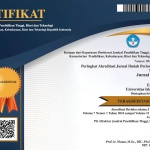The Assimilation and Integration Rights for Prisoners as Over Capacity Prevention Effort in the Covid-19 Pandemic
Abstract
Overcapacity Prisons in Indonesia are currently at an alarming stage, including the Class II A Gorontalo Prison, data shows that the prison population is 475 inmates while the prison can only accommodate 330 inmates. Such conditions are worrying in the midst of the COVID-19 pandemic, considering that the process of spreading this virus is so fast and can be transmitted to anyone. So that in the context of preventing and dealing with Covid-19, it is impossible to implement social restrictions in prisons, for example the application of social distancing. Various efforts have been made by the government to break the chain of the spread of this virus, with the issuance of Minister of Law and Human Rights No. 10 of 2020 and Kepmenkumham No. 19 of 2020 to ensure the safety of prisoners in prisons, but in reality, it has drawn criticism and caused its own unrest in the community. The specific purpose of this research is to find out and analyze the implementation of granting assimilation and integration rights for prisoners and to find out the form of anticipating strategies for overcapacity of Class II A Gorontalo prisons during the Covid-19 pandemic. The type of research used is empirical research, namely research with field data as the main data source, such as the results of interviews and observations. The results of this study indicate that (1) the implementation of granting assimilation and integration rights for prisoners is based on the regulation of the Minister of Law and Human Rights of the Republic of Indonesia No. 10 of 2020 and the Decree of the Minister of Law and Human Rights of the Republic of Indonesia No. M.HH-19 PK.01.04.04 of 2020. (2) The strategy to anticipate over capacity by the Class II A Gorontalo Penitentiary During the Covid 19 Pandemic was taken in several stages: a) Orientation Admission, b) Orientation Assimilation, c) Orientation Integration, and d) Assimilation.
Keywords
Full Text:
PDFReferences
Journals:
Haryono. (2018). Optimizing the Implementation of Duties and Functions of Open Prisons in the Convict Assimilation Process. Scientific Journal of Legal Policy, 12(3).
N. Qomar. (2017). Legal Research Methods. (Abd. Kahar Muzakkir, Ed.). Makassar: CV. Social Politic Genius (SIGN).
Nasir Djamil. (2015). Children are not to be punished. Jakarta: Sinar Graphic.
Samuel Arsheldon; et al. (2020). The Strategy for Anticipating Over Capacity in Prisons is a Reflection on Policies for Preventing the Spread of Covid-19. Adliya, Journal of Law and Humanity, 14(1).
Trisnawati. (2020). Providing Assimilation and Integration of Convicts and Children in the Context of Prevention and Overcoming the Spread of Covid-19. Dynamics: Scientific Journal of Legal Journal, 26(14).
Umronah, E. (2020). Juridical Analysis of Assimilation and Integration Supervision for Prisoners and Children During the Covid-19 Pandemic (Study at Class I Penitentiary Malang). Journal of Legal Spirit, 4(1).
DOI: https://dx.doi.org/10.30659/jdh.v5i3.23032
Refbacks
- There are currently no refbacks.
View My Stats

This work is licensed under a Creative Commons Attribution 4.0 International License.
Jurnal Daulat Hukum has been indexed in:

